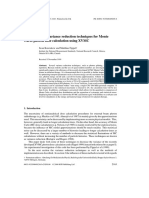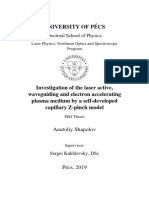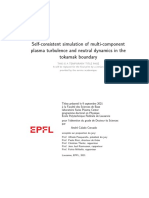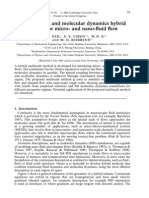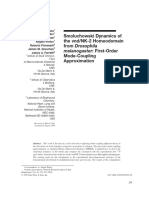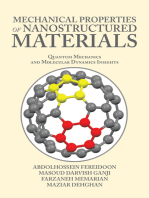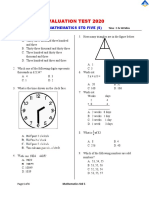A Monte Carlo dose calculation algorithm for proton therapy
Matthias Fippel
a)
Abteilung fu¨ r Medizinische Physik, Universita¨ tsklinikum Tu¨ bingen, Hoppe-Seyler-Str. 3, 72076 Tu¨ bingen,Germany
Martin Soukup
Department of Dosimetry and Application of Ionizing Radiation, Czech Technical University in Prague, Brehova 7, 11519 Praha, Czech Republic
Received 17 March 2004; revised 13 May 2004; accepted for publication 18 May 2004;published 23 July 2004
A Monte Carlo
MC
code
VMCpro
for treatment planning in proton beam therapy of cancer isintroduced. It is based on ideas of the Voxel Monte Carlo algorithm for photons and electrons andis applicable to human tissue for clinical proton energies. In the present paper the implementationof electromagnetic and nuclear interactions is described. They are modeled by a Class II condensedhistory algorithm with continuous energy loss, ionization, multiple scattering, range straggling,
-electron transport, nuclear elastic proton nucleus scattering and inelastic proton nucleus reactions.VMCpro is faster than the general purpose MC codes
FLUKA
by a factor of 13 and
GEANT4
by afactor of 35 for simulations in a phantom with inhomogeneities. For dose calculations in patientsthe speed improvement is larger, because VMCpro has only a weak dependency on the heteroge-neity of the calculation grid. Dose distributions produced with VMCpro are in agreement with
GEANT4
results. Integrated or broad beam depth dose curves show maximum deviations not largerthan 1% or 0.5 mm in regions with large dose gradients for the examples presented here. ©
2004 American Association of Physicists in Medicine.
DOI: 10.1118/1.1769631
Key words: proton therapy, Monte Carlo, treatment planning
I. INTRODUCTION
Presently, pencil beam algorithms
1–8
are employed for dosecalculation in proton therapy. They have the advantage of short calculation times, which is especially useful for inten-sity modulated proton therapy.
9
On the other hand, pencilbeam algorithms show accuracy limitations mainly becauseof the one-dimensional density scaling of proton pencilbeams in water.
10
To overcome these difficulties more so-phisticated scaling methods have been introduced.
10,11
Thesemethods could improve dose calculation considerably. How-ever, close to material interfaces there are remaining discrep-ancies to Monte Carlo calculated dose distributions.
11
Thereason is, multiple elastic Coulomb scattering in heteroge-neous media as well as elastic and inelastic nuclear reactionscan be implemented in pencil beam algorithms only approxi-mately. Further improvement of proton dose calculation canbe achieved using Monte Carlo
MC
algorithms.Some of the most serious problems in proton therapy to-day are patient set-up errors and organ motion. These uncer-tainties have a large impact on the treatment success, becausethe dose of proton beams can be placed with high precisionto specific locations within the patient. A small displacementof the Bragg–Peak can easily lead to tumor underdosage aswell as overdosage to organs at risk. Presently these effectsare taken into account during treatment planning by addingmargins to the clinical target volume. But in this manner thehigh precision of proton dose distributions decreases. Thus, itwill be extremely useful to reduce the margins by takingmotion effects into account during treatment planning. How-ever, they are difficult to simulate with pencil beam algo-rithms, because ray-tracing must be performed for time de-pendent density distributions. This increases calculation timeand may be clinically impractical. For MC algorithms, on theother hand, it is easy to model these effects by choosing thedensity in each voxel randomly from a pre-defined uncer-tainty distribution before starting the particle history. Thiscan be realized without increasing the calculation time com-pared to static Monte Carlo. Of course, the distribution func-tion of densities in each voxel must be known, e.g., by a timedependent set of computerized tomography
CT
cubes.Therefore, in near future MC algorithms will be preferred fortreatment planning in proton therapy if they are fast enough.Recently, Kohno
et al.
developed a simplified MonteCarlo
SMC
planning algorithm for proton beams based onmeasured depth dose distributions in water.
12
They stated,that in relatively short calculation time SMC agrees wellwith experimental results in a heterogeneous phantom. How-ever, further investigations will be necessary to quantify thecalculation time as well as the influence of these simplifica-tions on the results.Another option is the implementation of established gen-eral purpose MC codes like
GEANT4
,
13
FLUKA
,
14,15
or
MCNP
16
for treatment planning. However, as we will show in Sec.IIIE, these codes are still too slow for this type of simula-tions. For proton therapy treatment planning in future fastand accurate MC dose calculation algorithms are required.In the present paper a MC algorithm for proton beams,called VMCpro, is introduced. Here the implementation of electromagnetic and nuclear interactions is described. In thenext section the properties of the transport model are ex-plained. It is discussed how the cross sections and transport
2263 2263Med. Phys. 31
„
8
…
, August 2004 0094-2405
Õ
2004
Õ
31
„
8
…
Õ
2263
Õ
11
Õ
$22.00 © 2004 Am. Assoc. Phys. Med.
parameters are determined from a given distribution of massdensities. In Sec. III the new code is benchmarked using
GEANT4
and
FLUKA
in terms of accuracy and calculationtime.
II. METHODS
For treatment planning and optimization the models of patients are given by sets of computerized tomography
CT
images. Using standard CT calibration techniques these setsof images can be converted into three-dimensional
3D
grids of mass densities, called density matrices. Thus, thetransport of protons and secondary particles has to be simu-lated within voxelized geometries. This is identical to thesituation in traditional radiation therapy where the transportof photons and electrons must be simulated. This allows usto reuse ideas developed for the Voxel Monte Carlo
VMC
algorithm.
17–19
Therefore, the Monte Carlo code for protonbeams, presented here, is called VMCpro.
A. Proton transport algorithm
The most important component of VMCpro is the algo-rithm to model the transport of protons with different ener-gies through human tissue. This transport is influenced byelastic and inelastic Coulomb collisions with atomic nucleiand atomic electrons as well as elastic and inelastic nuclearreactions.Protons undergo a huge number
more than 10
6
percm)of elastic Coulomb interactions. Simulating this collision bycollision
analog Monte Carlo
would require too much cal-culation time. Therefore, a Class II condensed historyalgorithm
20
is implemented with production of
-electrons
ionizations
above the threshold energy
T
e
min
and continuousenergy loss below
T
e
min
. The parameter
T
e
min
can be specifiedby the user. It influences the ionization cross section
seeSec. IIB
and thus the number of
-electrons during thesimulation.The transport simulation starts with a proton of definitekinetic energy
T
p
and momentum at the surface of the cal-culation grid. The kinetic energy of this proton is absorbedlocally if it is smaller than the minimum energy
T
p
min
. Thisparameter can be defined by the user. We usually choose
T
p
min
0.5 MeV. The range of protons with smaller energy
less than 0.01 mm in water
is negligible with respect to thevoxel resolution. Even in air cavities this choice will be suf-ficient because of the small stopping power and nuclear in-teraction cross sections.
T
p
min
is also used to control the endof the simulation of each proton. The transport stops if thekinetic energy becomes smaller than the minimum energy.There is also a maximum energy
T
p
max
500 MeV. It is usedas upper limit of proton transport data tabulations. Thus thetypical clinical energies
from 60 to 270 MeV
are included.The VMCpro transport procedure traces protons throughthe grid step by step. One step is defined by the distancebetween two voxel boundaries if there is no discrete interac-tion in the present voxel. If there is a discrete interaction
ionization or nuclear reaction
one step is until this interac-tion point. The distance to the discrete interaction point isdetermined in energy space using the modified fictitious in-teraction method as described by Kawrakow
21
taking intoaccount ionization, elastic and inelastic nuclear reactions.Using the mass density
in the present voxel, the stoppingpower ratio to water
f
S
(
,
T
p
) can be determined
see Sec.IIC, Eq.
13
. This allows scaling of the geometrical steplength
z
to the corresponding step length in water
z
w
according to:
z
w
f
S
,
T
p
w
z
.
1
The energy loss
E
is identical for protons with geometricalstep length
z
in a medium with density
and protons of thesame energy with step length
z
w
in water. Using the re-stricted stopping power in water
L
w
(
T
p
,
T
e
min
)
see Sec. IID
and the integral
z
w
T
p
T
p
end
dT
p
L
w
T
p
,
T
e
min
,
2
it is possible to calculate the mean kinetic energy of theproton at the end of the step:
T
p
end
T
p
E
.
3
The real proton energy
T
p
end
at the end of the step fluctuatesaround its mean value. In Sec. IIE the implementation of thisenergy straggling is discussed.After moving the proton to the new position a multiplescattering angle is sampled
see Sec. IIF
and the proton isrotated according to this angle. The energy loss
E
is scoredin the present voxel and the new energy
T
p
end
is assigned tothe proton. If there is a discrete interaction at the end of thestep this interaction is simulated
see Secs. IIB and IIH
.This can lead to secondary particles, e.g.,
-electrons or sec-ondary protons. In this case the transport of these particles isalso simulated
see, e.g., Sec. IIG
.The proton history ends if it leaves the calculation grid orits energy becomes smaller than
T
p
min
. Otherwise the proce-dure continues with the simulation of a new step.
B. Ionization
For kinematic reasons the maximum energy
T
e
max
transfer-able to free electrons during ionization interactions is givenby
see, e.g., ‘‘The Review of Particle Physics’’
22
:
T
e
max
2
m
e
2
2
1
2
m
e
/
m
p
m
e
/
m
p
2
.
4
Here,
m
e
and
m
p
are the electron and proton rest masses inunits of energy, respectively,
is the ratio of proton velocityto the velocity of light and the relativistic parameter
isgiven by
E
p
/
m
p
with the total energy of the proton
E
p
T
p
m
p
.The differential macroscopic cross section for the produc-tion of
-electrons with kinetic energy
T
e
T
e
min
is calculatedby
see, e.g.,
GEANT4
,
Physics Reference Manual 2003
23
:
2264 M. Fippel and M. Soukup: A Monte Carlo dose calculation algorithm 2264Medical Physics, Vol. 31, No. 8, August 2004
d
dT
e
2
r
e
2
m
e
n
e
2
1
T
e
2
1
2
T
e
T
e
max
T
e
2
2
E
p
2
,
5
for materials with electron density
n
e
,
r
e
is the electron ra-dius. This cross section is zero for
T
e
max
T
e
min
. Using Eq.
5
the total macroscopic cross section
n
e
,
T
p
,
T
e
min
T
e
min
T
e
max
dT
e
d
dT
e
,
6
and the first moment
M
n
e
,
T
p
,
T
e
min
T
e
min
T
e
max
dT
e
T
e
d
dT
e
,
7
can be calculated analytically. Equation
5
also provides arejection method to sample the kinetic energy of the
-electron. First of all, this energy is sampled from distribu-tion
f
T
e
T
e
min
T
e
max
T
e
max
T
e
min
1
T
e
2
,
8
i.e., with
being a uniformly distributed random number in
0:1
,
T
e
is calculated according to:
T
e
T
e
min
T
e
max
1
T
e
max
T
e
min
.
9
Then, function
g
T
e
1
2
T
e
T
e
max
T
e
2
2
E
p
2
,
10
can be used as rejection weight.The polar scattering angle of the
-electron follows fromthe kinematics of this process. The azimuthal scatteringangle is sampled from a uniform distribution. Because of thelarge proton mass compared to the electron mass a directionchange of the proton can be neglected. The proton directionmainly changes due to multiple elastic scatter with theatomic nuclei
see Sec. IIF
or due to elastic nuclear colli-sions
see Sec. IIH
.
C. Stopping power ratio
The total proton stopping power is given by the sum of the electronic stopping power and the nuclear stoppingpower. Above 1 MeV kinetic energy the nuclear stoppingpower is negligible, i.e., protons are slowed down mainlybecause of inelastic interactions with the atomic electrons.The mass stopping power of a proton with kinetic energy
T
p
is defined by the energy loss
dT
p
along the path length
dz
and normalized by the mass density
, i.e.,
S
,
T
p
1
dT
p
,
T
p
dz
,
11
with
S
(
,
T
p
) being the linear stopping power. For humantissue, it is possible to express the stopping power of a ma-terial with mass density
as a function of the mass stoppingpower in water
S
w
(
T
p
)/
w
. For this reason we define thestopping power ratio
f
S
,
T
p
w
S
,
T
p
S
w
T
p
.
12
After analyzing the tabulations and calculations of ICRU Re-port 46,
24
ICRU Report 49,
25
and the computer tool
PSTAR
26
we develop the following fit formula:
f
S
,
T
p
1.0123
3.386 10
5
T
p
0.291
1
T
p
0.3421
0.7
1
for
0.90.9925 for
0.26
lung
0.8815 for
0.0012
air
interpolate for all other
0.9,
13
with the kinetic proton energy
T
p
in MeV and mass density
in gcm
3
. Figure 1 shows this function for two proton en-ergies
10 and 100 MeV
compared to the ICRU Report 46data.
24
Beside the outliers
Gallstone, Protein, Carbohydrateand Urinary Stone
, Eq.
13
provides an accuracy of betterthan 1%. This fit allows the scaling of Eq.
1
during MCsimulations based on mass densities only. Knowledge of theatomic composition in each voxel is not necessary. Equation
13
can also be applied to pencil beam algorithms.
D. Restricted stopping power in water
The restricted stopping power in water
L
w
(
T
p
,
T
e
min
) mustbe known to calculate the energy loss of protons based onEq.
2
. This value depends on the total stopping power inwater and the first moment of the ionization cross sectiondue to:
L
w
T
p
,
T
e
min
S
w
T
p
M
w
T
p
,
T
e
min
.
14
M
w
(
T
p
,
T
e
min
) is determined using Eq.
7
, therefore, the re-stricted stopping power depends on
T
e
min
. It models ioniza-tion processes below the energy threshold. The total stoppingpower
S
w
(
T
p
) is taken from PSTAR.
26
L
w
(
T
p
,
T
e
min
) is cal-
F
IG
. 1. Mass stopping power ratios of all materials from ICRU Report 46
Ref. 24
to the mass stopping power of water for 10 MeV and 100 MeVprotons
crosses
. The lines represent the fit of Eq.
13
for both energies.
2265 M. Fippel and M. Soukup: A Monte Carlo dose calculation algorithm 2265Medical Physics, Vol. 31, No. 8, August 2004
culated and tabulated during the initialization of VMCpro forthe given
T
e
min
. In the neighborhood of
T
p
it can be param-eterized as
L
w
T
p
a
T
p
T
p
[
b
(
T
p
)
1]
,
15
with
b
(
T
p
) being an almost constant function. If the param-eter
b
(
T
p
) is also calculated and tabulated prior to the MCsimulation, the integral of Eq.
2
can be evaluated efficientlyand accurately.
E. Energy straggling
The production of secondary electrons during ionizationinteractions leads to energy fluctuations of the primary pro-tons. This influences the steepness of the depth dose distri-bution behind the Bragg–Peak and must be taken into ac-count during dose calculation. It is taken into accountautomaticly for
-electron production above
T
e
min
. That is, if we choose
T
e
min
small enough the dose is correctly predictedwithout the need for applying energy straggling. However,the calculation time increases because a huge number of
-electrons is created. Even if the energy of these electrons isabsorbed locally, the computation time remains unacceptablylong. Therefore, we have implemented the sub-thresholdstraggling distribution introduced by Bohr
27
and described inICRU Report 49
25
and the
GEANT4
Physics Reference Manual
.
23
That is, we model the straggling function by aGaussian with mean
E
from Eq.
3
and variance:
2
2
r
e
2
m
e
n
e
z
min
T
e
min
,
T
e
max
2
1
2
2
.
16
The last term (1
2
/2) provides a relativistic correction toBohr’s variance.Using this approach we have calculated proton beam dosedistributions in water for various threshold energies
T
e
min
.The final result
especially in the Bragg–Peak region
doesnot depend on the parameter
T
e
min
. This means, the conditionof long step lengths to implement Bohr’s model is valid forour purposes. Only the calculation time is affected by
T
e
min
.
F. Multiple scattering
Protons traversing matter are mainly scattered because of elastic Coulomb interactions with atomic nuclei. This leadsto many small-angle deflections. Therefore, the small-angleapproximation can be applied to the multiple scatteringtheory. This leads to a Gaussian distribution
22
with a widthintroduced by Rossi and Greisen:
28
02
E
s
p
2
z X
0
.
17
Here,
p
is the proton momentum and
X
0
(
) is the radiationlength of the material.
E
s
is a constant parameter, indepen-dent on proton energy and material composition.The parameter
E
s
is determined by fitting differential dosedistributions as calculated by VMCpro to simulations using
GEANT4
13
in water with nuclear reactions switched off. Using
GEANT4
version 5.1 we estimated
E
s
12.4 MeV. When ver-sion 5.2 was released, we modified the value to
E
s
12.0 MeV. This was necessary because the implementa-tion of multiple scattering in
GEANT4
has changed betweenthe versions. By using
FLUKA2002.4
14,15
instead of
GEANT4
forfitting, the parameter must be changed to
E
s
12.9 MeV.Figure 2 shows central axis depth dose curves in water of 100 MeV pencil beams with a voxel resolution of 1 mmcalculated with
GEANT4
version 5.1,
GEANT4
version 5.2, and
FLUKA2002.4
, without nuclear reactions. The differences canbe explained by different multiple scattering distributionsimplemented in
GEANT4
and
FLUKA
. Strictly speaking, theparameter
E
s
should be determined by measurement or atheoretical computation. Therefore, additional investigationswill be necessary. But this is not the task of the presentpaper, we just provide a method to adjust our model to anymultiple scattering algorithm. Furthermore, the differencesvanish for integrated or broad beam depth dose curves. Theyhave only a slight influence on broad beam profile doses inthe Bragg–Peak region.To determine the radiation length
X
0
(
) for a materialwith mass density
in the present voxel we define the ratio:
f
X
0
w
X
w
X
0
18
with the radiation length of water
X
w
36.0863 cm. Thecrosses in Fig. 3 show this ratio as a function of
for allmaterials defined in ICRU Report 46.
24
As in EGSnrc,
21
theradiation lengths
X
w
and
X
0
(
) for elements are calculatedusing Tsai’s formula
29
and the radiation lengths for com-pounds are derived from the elemental values. The densitydependence of
f
X
0
(
) can be represented accurately usingthe fit:
f
X
0
1.19
0.44ln
0.44
for
0.91.0446
0.2180
for 0.26
0.90.9857
0.0085
for
0.26,
19
F
IG
. 2. Central axis depth dose distributions in water for monoenergeticproton pencil beams of 100 MeV, calculated with
GEANT4
version 5.1,
GEANT4
version 5.2 and
FLUKA2002
. Nuclear reactions are switched off.
2266 M. Fippel and M. Soukup: A Monte Carlo dose calculation algorithm 2266Medical Physics, Vol. 31, No. 8, August 2004












